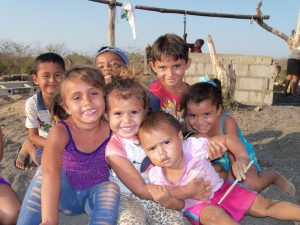Hello readers,
What do you notice when you see this image?
Perhaps the first thing that might have caught your eye was the amount of waste piled high in the background or perhaps it was the dirty hands enveloping the young child’s face? Maybe it was the thin dog walking towards the boy with its ears pulled back and its legs so tiny that they could snap at any step?
They say a picture is worth a thousand words but does a picture always depict reality?
With the ever-increasing globalization on our planet, we are becoming more and more aware of the living conditions that people are faced with on a daily-basis around the world. Living in a relatively highly developed country, we have access to multiple media outlets that constantly remind us of what is going on in the world around us. Whether it’s in the morning newspaper delivered at our doorstep, on the radio while driving to work, on our newsfeed while scrolling through Facebook, Instagram and Twitter or on the 5pm news when we come home at the end of a long day; the media is always present. It is part of our everyday routines to tune in to these media outlets where we are shown graphic images and videos of the disasters and of the poverty that currently exists in regions all over the world. But do these images really reveal the truth or is it the truth that they are concealing?
The image above was taken in the community of El Limonal which is a garbage dump located just outside of the city of Chinandega, Nicaragua. Close to 3000 people live here, scrounging through scraps and throw-a-ways in hopes of finding items they can later sell for whatever little sum of money they can get. Garbage disposal in the area is not highly developed so it is very common to see piles of garbage being burned throughout the community. The fumes that come off as a result of the burning are extremely toxic and affect the breathing all those living in the community. Now these were the facts and images I heard about this community prior to visiting it for myself, so evidently I expected to enter a world of dispirited people and depressing terrain.
The reality that I found however? A group of endearing, grateful and purely happy people.

In my Arts Studies course (ASTU 100A) that I am taking at the University of British Columbia in the CAP: Global Citizens Stream, we have been reading and analyzing Marjane Satrapi’s graphic narrative: Persepolis in which we are able to see the perspective of a young girl who is growing up during the Iran-Iraq war throughout the 1980s. The choice that Satrapi made in creating a graphic narrative was an interesting one that has intrigued me since day one. Why choose to use drawings to depict such a grim and difficult topic? At first, I came to the conclusion that images can make it easier for readers to understand events that are taking place. Images, after all are worth a thousand words, right? As I kept thinking about it however, I began to question: do these images really depict the entire reality?
To begin with, on page three, Satrapi draws an image of her classmates stating “This is a class photo. I’m sitting on the far left so you don’t see me.” This was an example that we discussed in class, demonstrating the fact that Satrapi has the complete control and power over what we see and what we don’t see, of what she reveals and what she conceals. Another example of this is with the topic of the veil. In the book, the religious veil is portrayed as a negative symbol of oppression by Marji, however had this story been told by a member of the revolutionaries, believing strictly in the Muslim regime in Iran, the images of the veil would have been drawn eminently differently. Rather than seeing a field full of children running around with the veils on their heads, flying around in the air and used as skipping ropes, we might see a more serious image of straight-faced children attending school and obeying orders. Finally, the fact that this story is written by an adult, remembering and reflecting on the perspective she had as a young child demonstrates the fact that not everything that is told is wholly accurate and that the images that are drawn are not able to depict everyone’s reality. As readers, we are seeing the story from the perspective of one child from one social class with one specific way of thinking but what about the story told from the perspective of an adult? A lower social class? Different beliefs? What about the perspective of the story told from the media or from the Shah’s kingdom? Or perhaps the story told from an outsider such as myself?
Whether you’re seeing an image of a poverty-stricken country, a headline in the local newspaper or a series of images in a graphic narrative, one must always keep one’s eyes open to the possibility of different perspectives to each and every story that is told in our everyday lives.

Recent Comments